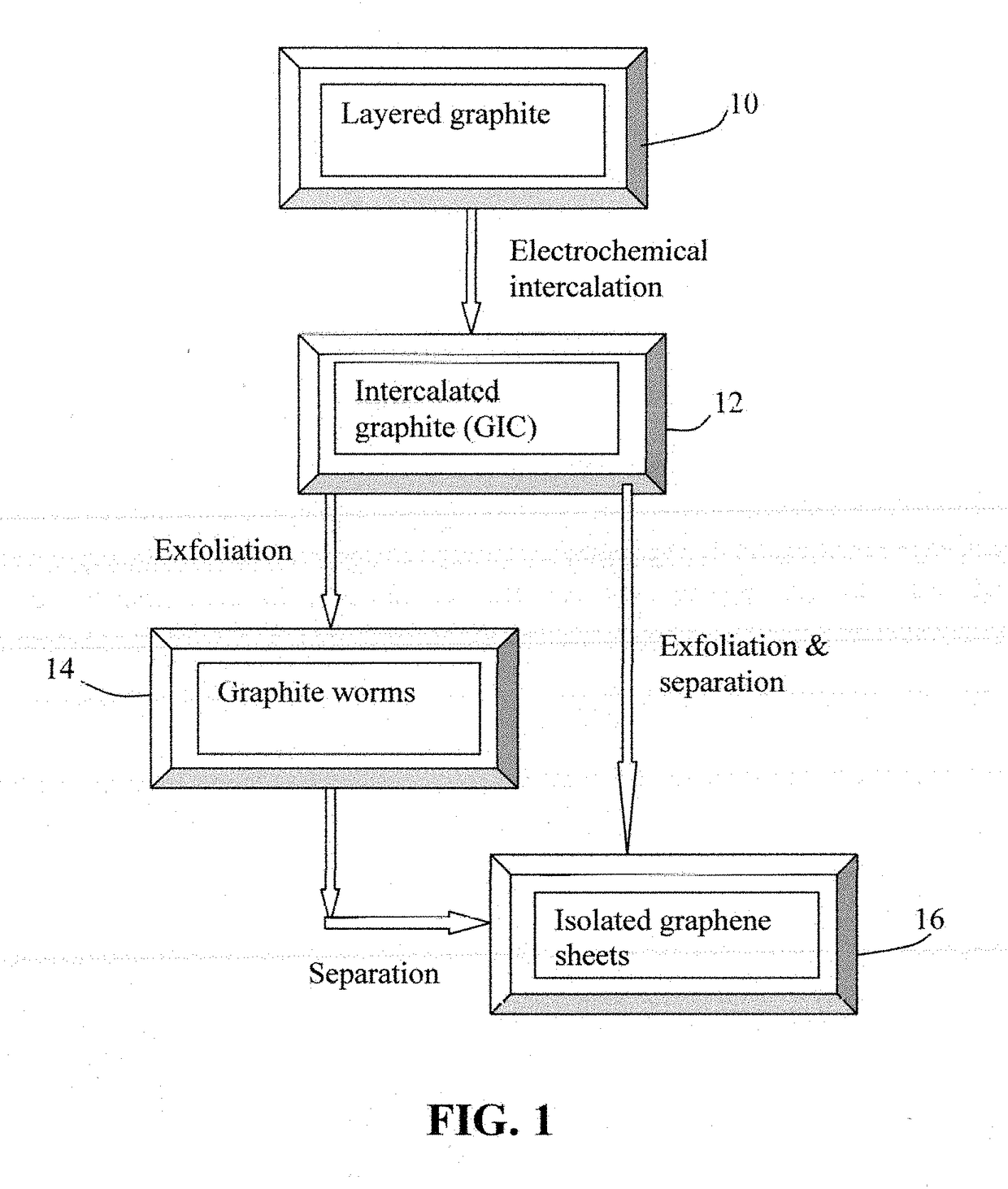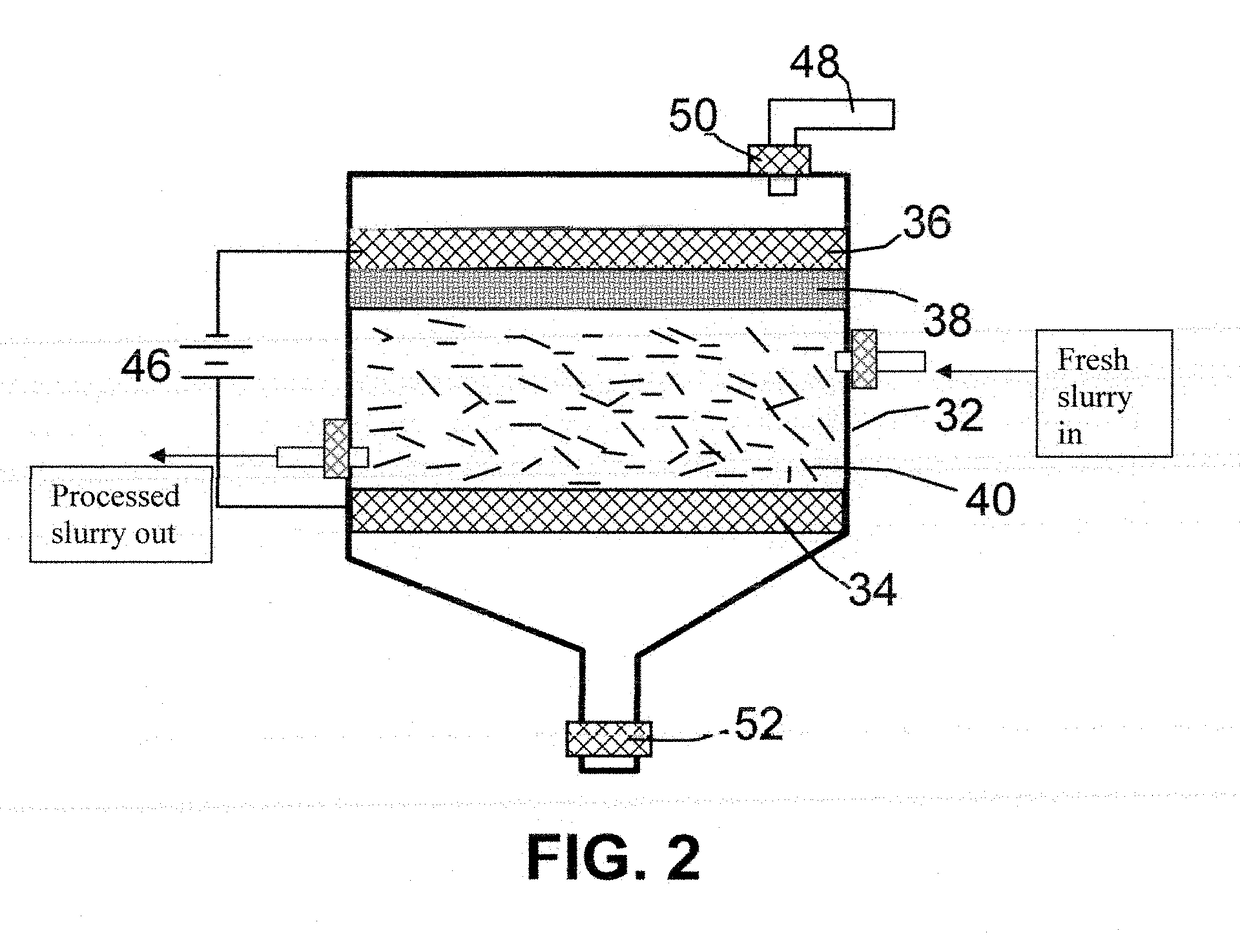Electrochemical Method Of Producing Single-Layer Or Few-Layer Graphene Sheets
a technology of isolated graphene and electrochemical methods, which is applied in the production of single-layer graphene, electrolysis organic products, electrolysis components, etc., can solve the problems of inability to mass produce ngps, process is not suitable for mass production of isolated graphene sheets for composite materials and energy storage applications, and heat-induced exfoliation approaches require a very tedious washing and purification step
- Summary
- Abstract
- Description
- Claims
- Application Information
AI Technical Summary
Benefits of technology
Problems solved by technology
Method used
Image
Examples
example 1
Production of Isolated Graphene Sheets from Synthetic Graphite
[0061]One gram of meso-carbon micro-beads (MCMBs), having an average diameter 4), sodium perchlorate (NaClO4), potassium perchlorate (KClO4), and their mixtures.
[0062]The anode supporting element is a stainless steel plate and the cathode is a graphite foam of approximately 4 cm in diameter and 0.2 cm in thickness, impregnated with lithium or sodium. The separator, a glass fiber fabric, was used to separate the cathode plate from the MCMB particles and to compress these particles down against the anode supporting element to ensure that the MCMBs are in electrical connection with the anode supporting element to serve as the anode. The electrodes, electrolyte, and separator are contained in a Buchner-type funnel to form an electrochemical cell. The anode supporting element, the cathode, and the separator are porous to permit intercalate (contained in the electrolyte) to saturate the graphite and to pass through the cell fro...
example 2
Graphene Sheets from Milled Graphite Rock (Graphite Ore or Mineral)
[0071]Samples of two grams each of graphite rock containing 56% natural flake graphite were milled down to 50 mesh particle size. The powder samples were subjected to similar electrochemical intercalation conditions described in Example 1, but with different alkali metal salts and solvents. The graphite rock powder samples were subjected to an electrochemical intercalation treatment at a current of 0.5 amps (current density of about 0.04 amps / cm2) and at a cell voltage of about 6 volts for 3 hours. Following the electrochemical intercalation treatment, the resulting intercalated flake was removed from the electrochemical reactor and dried.
[0072]Subsequently, the intercalated compound was transferred to a furnace pre-set at a temperature of 950° C. for 45 seconds. The compound was found to induce rapid and high expansions of graphite crystallites with an expansion ratio of greater than 100. After a mechanical shearing...
example 3
Production of Isolated Graphene Sheets from Electrochemical Interaction, Exfoliation, and Separation of Purified Natural Graphite
[0075]Samples of two grams each of purified natural graphite powder were milled down to 50 mesh particle size. The powder samples were subjected to similar electrochemical intercalation conditions described in Example 1, but with different alkali metal salts and solvents. The natural graphite samples were subjected to an electrochemical intercalation treatment at a current of 0.5 amps (current density of about 0.04 amps / cm2) and at a cell voltage of about 6 volts for 3 hours. Following the electrochemical intercalation treatment, the resulting intercalated graphite (mostly Stage-1 GIC with some Stage-2) was removed from the electrochemical reactor and dried.
[0076]Subsequently, the intercalated compound was transferred to a furnace pre-set at a temperature of 1,050° C. for 60 seconds. The compound was found to induce rapid and high expansions of graphite cr...
PUM
| Property | Measurement | Unit |
|---|---|---|
| thickness | aaaaa | aaaaa |
| thickness | aaaaa | aaaaa |
| current density | aaaaa | aaaaa |
Abstract
Description
Claims
Application Information
 Login to View More
Login to View More - R&D
- Intellectual Property
- Life Sciences
- Materials
- Tech Scout
- Unparalleled Data Quality
- Higher Quality Content
- 60% Fewer Hallucinations
Browse by: Latest US Patents, China's latest patents, Technical Efficacy Thesaurus, Application Domain, Technology Topic, Popular Technical Reports.
© 2025 PatSnap. All rights reserved.Legal|Privacy policy|Modern Slavery Act Transparency Statement|Sitemap|About US| Contact US: help@patsnap.com



